| Drongo | |
|---|---|

| |
| Hair-crested drongo (D. hottentottus striatus) | |
| Scientific classification | |
| Domain: | Eukaryota |
| Kingdom: | Animalia |
| Phylum: | Chordata |
| Class: | Aves |
| Order: | Passeriformes |
| Superfamily: | Corvoidea |
| Family: | Dicruridae Vigors, 1825 |
| Genus: | Dicrurus Vieillot, 1816 |
| Type species | |
| Corvus balicassius (Balicassiao) Linnaeus, 1766 | |
| Dicrurus phylogeny | |||||||||||||||||||||||||||||||||||||||||||||||||||||||||||||||||||||||||||||||||||||||||||||||||||||||||
| |||||||||||||||||||||||||||||||||||||||||||||||||||||||||||||||||||||||||||||||||||||||||||||||||||||||||
| Cladogram based on a study by Eric Pasquet and colleagues published in 2007. |
A drongo is a member of the family Dicruridae of passerine birds of the Old World tropics. The 28 species in the family are placed in a single genus, Dicrurus.
Drongos are mostly black or dark grey, short-legged birds, with an upright stance when perched. They have forked tails and some have elaborate tail decorations. They feed on insects and small birds, which they catch in flight or on the ground. Some species are accomplished mimics and have a variety of alarm calls, to which other birds and animals often respond. They are known to utter fake alarm calls that scare other animals off food, which the drongo then claims.
Taxonomy
The genus Dicrurus was introduced by French ornithologist Louis Pierre Vieillot for the drongos in 1816. The type species was subsequently designated as the balicassiao (Dicrurus balicassius) by English zoologist George Robert Gray in 1841. The name of the genus combines the Ancient Greek words dikros "forked" and oura "tail". "Drongo" is originally from the indigenous language of Madagascar, where it refers to the crested drongo; it is now used for all members of the family.
This family now includes only the genus Dicrurus, although Christidis and Boles (2007) expanded the family to include the subfamilies Rhipidurinae (Australasian fantails), Monarchinae (monarch and paradise flycatchers), and Grallininae (magpie larks).
The family was formerly treated as having two genera, Chaetorhynchus and Dicrurus. The genus Chaetorhynchus contains a single species, the New Guinea-endemic C. papuensis. On the basis of both morphological and genetic differences, it is now placed with the fantails (Rhipiduridae) and renamed from the pygmy drongo to the drongo fantail.
The genus Dicrurus contains 28 species:
| Image | Common Name | Scientific name | Distribution |
|---|---|---|---|
 |
Square-tailed drongo | Dicrurus ludwigii | southern Africa. |
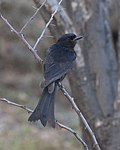 |
Sharpe's drongo | Dicrurus sharpei | southern South Sudan and western Kenya to the Democratic Republic of the Congo to Nigeria |
 |
Shining drongo | Dicrurus atripennis | Cameroon, Central African Republic, Republic of the Congo, Democratic Republic of the Congo, Ivory Coast, Equatorial Guinea, Gabon, Ghana, Guinea, Liberia, Nigeria, Sierra Leone, and Togo. |
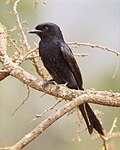 |
Fork-tailed drongo | Dicrurus adsimilis | Gabon, Congo Republic, DRC, Angola, northwestern Zambia, Namibia, Botswana and northwestern South Africa |
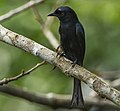 |
Velvet-mantled drongo | Dicrurus modestus | Nigeria and Cameroon to the Democratic Republic of Congo and Angola. |
| Grande Comore drongo | Dicrurus fuscipennis | Comoros. | |
 |
Aldabra drongo | Dicrurus aldabranus | Seychelles |
 |
Crested drongo | Dicrurus forficatus | Madagascar and Comoros |
| Mayotte drongo | Dicrurus waldenii | Mayotte. | |
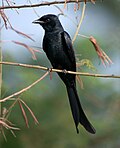 |
Black drongo | Dicrurus macrocercus | Iran through Pakistan, India, Bangladesh and Sri Lanka east to southern China and Indonesia and accidental visitor of Japan |
 |
Ashy drongo | Dicrurus leucophaeus | eastern Afghanistan east to southern China, Ryukyu Islands in southern Japan (particularly Okinawa) and Indonesia. |
 |
White-bellied drongo | Dicrurus caerulescens | India and Sri Lanka. |
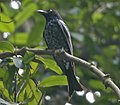 |
Crow-billed drongo | Dicrurus annectens | Bangladesh, Bhutan, Brunei, Cambodia, China, India, Indonesia, Laos, Malaysia, Myanmar, Nepal, Philippines, Singapore, Thailand, and Vietnam. |
 |
Bronzed drongo | Dicrurus aeneus | western Uttaranchal eastwards into Indochina and Hainan, the Malay Peninsula, Sumatra and northern Borneo |
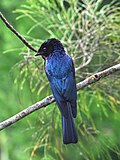 |
Lesser racket-tailed drongo | Dicrurus remifer | Bangladesh, Bhutan, Cambodia, India, Indonesia, Laos, Malaysia, Myanmar, Nepal, Thailand, and Vietnam. |
 |
Balicassiao | Dicrurus balicassius | Philippines. |
| Short-tailed drongo | Dicrurus striatus | Philippines. | |
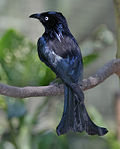 |
Hair-crested drongo | Dicrurus hottentottus | Bangladesh, India, and Bhutan through Indochina to China, Indonesia, and Brunei. |
| Tablas drongo | Dicrurus menagei | Philippines. | |
| Palawan drongo | Dicrurus palawanensis | Palawan. | |
| Sumatran drongo | Dicrurus sumatranus | Sumatra in Indonesia. | |
 |
Wallacean drongo | Dicrurus densus | Indonesia and East Timor. |
 |
Sulawesi drongo | Dicrurus montanus | Sulawesi in Indonesia. |
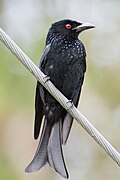 |
Spangled drongo | Dicrurus bracteatus | Australia, New Guinea, Indonesia |
| Paradise drongo | Dicrurus megarhynchus | New Ireland in the Bismarck Archipelago, Papua New Guinea. | |
 |
Andaman drongo | Dicrurus andamanensis | Andaman Islands |
 |
Greater racket-tailed drongo | Dicrurus paradiseus | India to Borneo and Java |
 |
Sri Lanka drongo | Dicrurus lophorinus | Sri Lanka. |
The family Dicruridae is most likely of Indo-Malayan origin, with a colonization of Africa about 15 million years ago (Mya). Dispersal across the Wallace Line into Australasia is estimated to have been more recent, around 6 Mya.
Characteristics

These insectivorous birds are usually found in open forests or bush. Most are black or dark grey in colour, sometimes with metallic tints. They have long, forked tails; some Asian species have elaborate tail decorations. They have short legs and sit very upright whilst perched, like a shrike. They flycatch or take prey from the ground. Some drongos, especially the greater racket-tailed drongo, are noted for their ability to mimic other birds and even mammals.
Two to four eggs are laid in a nest high in a tree. Despite their small size, they are aggressive and fearless, and will attack much larger species if their nests or young are threatened.
Several species of animals and birds respond to drongos' alarm calls, which often warn of the presence of a predator. Fork-tailed drongos in the Kalahari Desert use alarm calls in the absence of a predator to cause animals to flee and abandon food, which they eat, getting up to 23% of their food this way. They not only use their own alarm calls, but also imitate those of many species, either their victim's or that of another species to which the victim responds. If the call of one species is not effective, perhaps because of habituation, the drongo may try another; 51 different calls are known to be imitated. In one test on pied babblers, the babbler ignored an alarm call repeated three times when no danger was present, but continued to respond to different calls. Researchers have considered the possibility that these drongos possess theory of mind, not fully shown in any animal other than humans.
Insult
The word "drongo" is used in Australian English as a mild form of insult meaning "idiot" or "stupid fellow". This usage derives from an Australian racehorse of the same name (apparently after the spangled drongo, D. bracteatus) in the 1920s that never won despite many places. The word also has been frequently used among friends and can be used in a casual or serious tone.
Gallery
- A greater racket-tailed drongo preening at Khao Yai National Park, Thailand
-
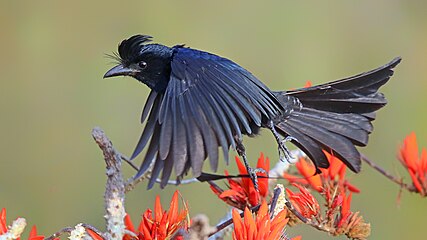 A greater racket-tailed drongo visiting Erythrina flowers at Satchari National Park in Bangladesh
A greater racket-tailed drongo visiting Erythrina flowers at Satchari National Park in Bangladesh
-
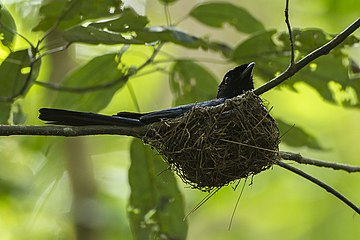 A lesser racket-tailed drongo incubating at Kaeng Krachan National Park in Thailand
A lesser racket-tailed drongo incubating at Kaeng Krachan National Park in Thailand
See also
![]() The dictionary definition of drongo at Wiktionary
The dictionary definition of drongo at Wiktionary
References
- ^ Pasquet, Eric; Pons, Jean-Marc; Fuchs, Jerome; Cruaud, Corinne; Bretagnolle, Vincent (2007). "Evolutionary history and biogeography of the drongos (Dicruridae), a tropical Old World clade of corvoid passerines". Molecular Phylogenetics and Evolution. 45 (1): 158–167. Bibcode:2007MolPE..45..158P. doi:10.1016/j.ympev.2007.03.010. PMID 17468015.
- Vieillot, Louis Pierre (1816). Analyse d'Une Nouvelle Ornithologie Élémentaire (in French). Paris: Deterville/self. p. 41.
- Gray (1841). A List of the Genera of Birds : with their Synonyma and an Indication of the Typical Species of Each Genus (2nd ed.). London: R. and J.E. Taylor. p. 47.
- Mayr, Ernst; Greenway, James C. Jr, eds. (1962). Check-list of birds of the world. Vol. 15. Cambridge, Massachusetts: Museum of Comparative Zoology. p. 138.
- Jobling, J.A. (2018). del Hoyo, J.; Elliott, A.; Sargatal, J.; Christie, D.A.; de Juana, E. (eds.). "Key to Scientific Names in Ornithology". Handbook of the Birds of the World Alive. Lynx Edicions. Retrieved 29 March 2018.
- Lindsey, Terence (1991). Forshaw, Joseph (ed.). Encyclopaedia of Animals: Birds. London: Merehurst Press. pp. 223–224. ISBN 1-85391-186-0.
- Christidis, Les; Walter Boles (2008) Systematics and Taxonomy of Australian Birds. Csiro Publishing, Australia. p. 174
- Irested, Martin; Fuchs, J; Jønsson, KA; Ohlson, JI; Pasquet, E; Ericson, Per G.P. (2009). "The systematic affinity of the enigmatic Lamprolia victoriae (Aves: Passeriformes)—An example of avian dispersal between New Guinea and Fiji over Miocene intermittent land bridges?" (PDF). Molecular Phylogenetics and Evolution. 48 (3): 1218–1222. doi:10.1016/j.ympev.2008.05.038. PMID 18620871.
- Gill, Frank; Donsker, David, eds. (2018). "Orioles, drongos, fantails". World Bird List Version 8.1. International Ornithologists' Union. Retrieved 29 March 2018.
- Flower, T.P. (2014). "Deception by flexible alarm mimicry in an African bird". Science. 344 (6183): 513–516. Bibcode:2014Sci...344..513F. doi:10.1126/science.1249723. PMID 24786078.
- National Geographic: African Bird Shouts False Alarms to Deceive and Steal, Study Shows Drongos in the Kalahari are masters of deception, 1 May 2014
- Flower, T. (2010). "Fork-tailed drongos use deceptive mimicked alarm calls to steal food". Proceedings of the Royal Society B. 278 (1711): 1548–1555. doi:10.1098/rspb.2010.1932. PMC 3081750. PMID 21047861.
- Green, Jonathon (2005). Cassell's Dictionary of Slang. London, UK: Orion Publishing Group. p. 450. ISBN 978-0-304-36636-1.
- Wannan, Bill (1979) . "Drongo". Australian Folklore. Lansdowne Press. p. 200. ISBN 0-7018-1309-1.
- "Drongo". Oxford Dictionary. Oxford University Press. Archived from the original on February 8, 2017. Retrieved 27 February 2017.
- "Career of Drongo". The News (Adelaide). Vol. IV, no. 568. South Australia. 20 May 1925. p. 3. Retrieved 14 February 2018 – via National Library of Australia.
Further reading
- Clancey, P.A. (1976). "Miscellaneous taxonomic notes on African birds XLIV". Durban Museum Novitates. 11 (4): 85–105 . Archived from the original on 29 October 2020.
- Vaurie, C. (1949). "A revision of the bird family Dicruridae". Bulletin of the American Museum of Natural History. 93: 203–342. hdl:2246/1240.
External links
- Drongo videos on the Internet Bird Collection
| Genera of corvides and their extinct allies | |||||||||||||||||||||||||||||||||||||
|---|---|---|---|---|---|---|---|---|---|---|---|---|---|---|---|---|---|---|---|---|---|---|---|---|---|---|---|---|---|---|---|---|---|---|---|---|---|
| |||||||||||||||||||||||||||||||||||||
| |||||||||||||||||||||||||||||||||||||
| |||||||||||||||||||||||||||||||||||||
| Taxon identifiers | |
|---|---|
| Dicruridae | |







